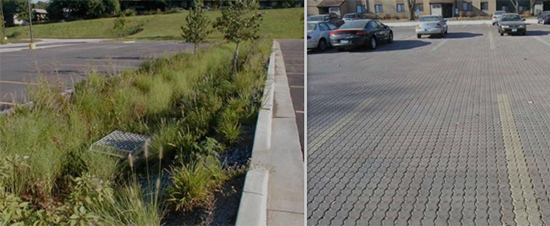Lafayette Station Site Improvements Project
Construction Announcements
1/10/2019 update: Progress continues to be made on the Lafayette Station Site Project with work crews putting the finishing touches on several improvements. Three new bio retention areas that will provide cleaner storm water runoff and help protect Happy Valley Creek are almost finished. Work is also moving forward on the installation of new signage as well as the planting of trees. The goal is to complete the project in early 2019.
See latest update notice here.
Started in June 2017, construction work is taking place on the northwest parking lots of the Lafayette Station. The project is expected to be complete in early 2019.
Phase 1 includes temporary relocation of the ADA lot and intermodal zone. Permit parking will relocate to Lot C. Lot B will be temporarily closed and reopen at end of Phase 1.
Phase 2 includes temporary relocation of the permit lot adjacent to Happy Valley Rd.
Entrance to the north side of the station will remain open during construction during both phases.
During construction, you can use County Connection bus routes 6 and 25 to get to the station. For more information go to: https://countyconnection.com/maps-schedules/
We apologize for this inconvenience and appreciate your patience. We will continue to update all interested parties so please check back regularly.
Project Description
The Lafayette Station Site Improvement project is a holistic and integrated effort combining intermodal improvements with storm water management improvements. This project consists of a redesign of the intermodal configurations of the station and installation of pervious pavers and rain gardens to capture, detain, and treat storm water runoff from the site’s parking and vehicular areas.
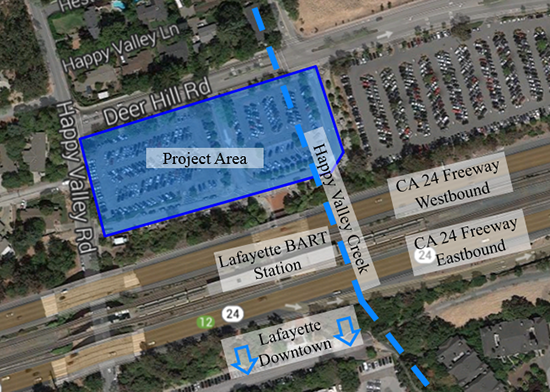
Project Area Location
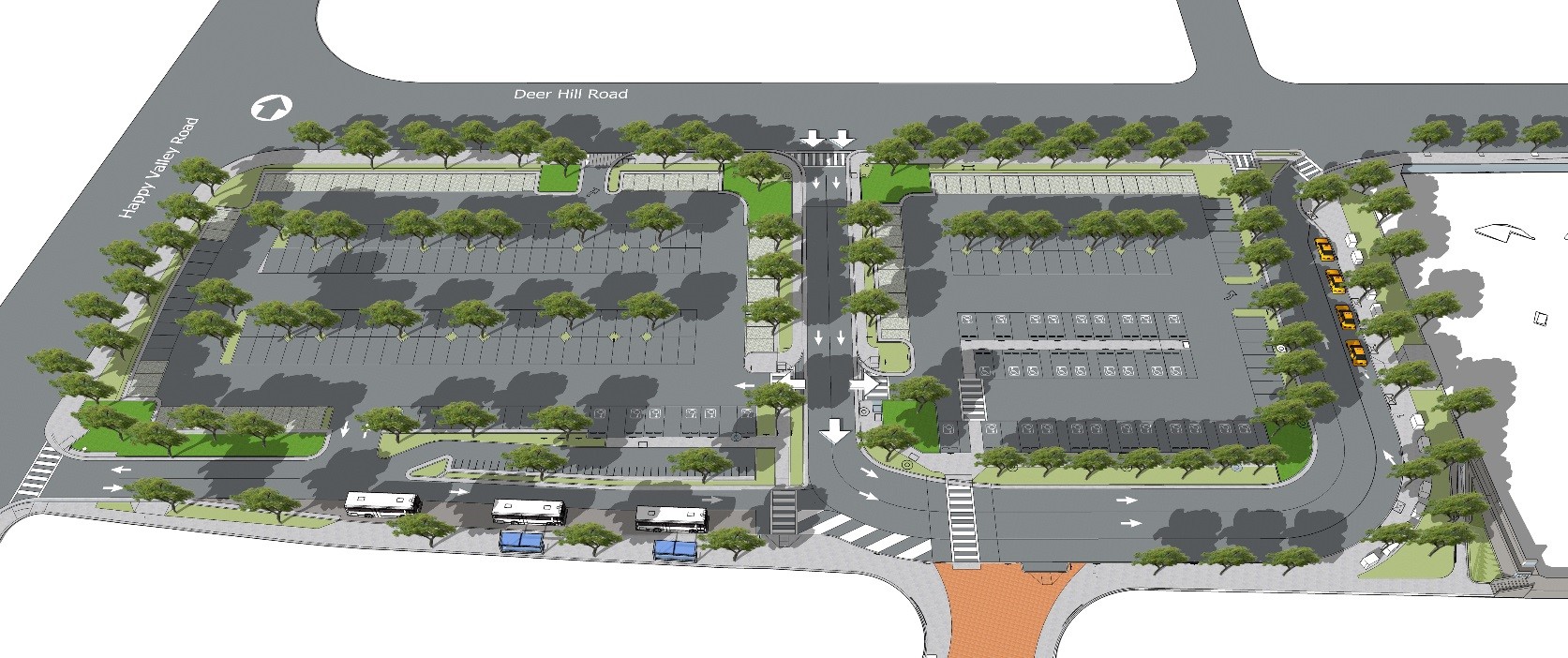
Rendering of New Parking and Intermodal Configuration
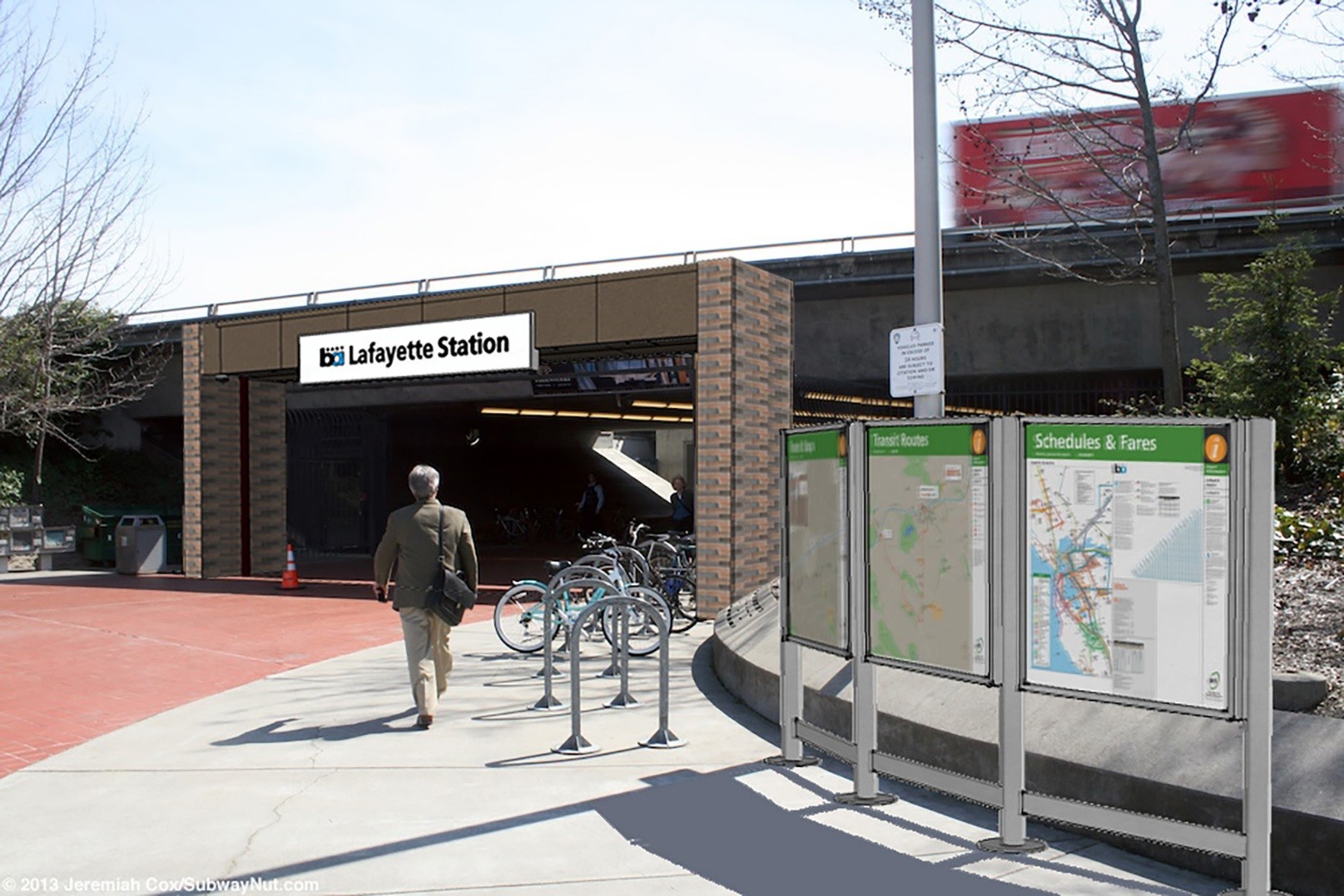
Rendering of Station Entrance
Project Goals
The project addresses traffic issues at the intermodal section and is making improvements to optimize traffic, lower congestion, and better align mode priorities. The following are the project goals.
Intermodal
- Meet ADA compliant parking and access requirements
- Improve vehicular queuing in the intermodal zone
- Improve pedestrian visibility and access to station
- Relocate and resize trash enclosures to improve functionality and access
- Provide ADA compliant connection from station to upper parking lot
- Provide bus stops for up to 2 full-size County Connection buses
- Replace and relocate bus shelter
- Improve vehicular circulation, visibility, and access from Deer Hill Road and Happy Valley Road
- Maintain bicycle amenities
- Provide LED lighting in the parking lots
Storm Water Management
- Provide effective storm water runoff capture and treatment through rain gardens and pervious pavers
- Satisfy MS4 permit requirements
Find out more of BART's efforts here.
Using the Power of Nature
One of the key improvements of the project is the installation of permeable pavers and rain gardens. These measures are known as low impact development (LID) and refer to systems and practices that use or mimic natural processes that result in infiltration, evapotranspiration or use of storm water to protect water quality and associated aquatic habitat. Older conventional designs create impervious surfaces and direct the runoff to storm water drain system without treatment. LID takes a different approach by viewing storm water as a resource rather than a waste product. LID promotes the natural movement of water within an ecosystem. The permeable pavers and rain gardens are designed to treat the runoff from the parking lot areas from potential storm water contaminants including hydrocarbons, sediments, heavy metals, trash and debris, oil and grease, and nutrients. Potential sources of this contamination include pavement wear, vehicular traffic, maintenance activities, tire wear, brake lining wear, motor oil and gasoline leaks, auto body rust, atmospheric deposition, and trash.[1]
Examples of Rain Garden (left) and Permeable Pavers (right)
LID can help to maintain or restore a watershed’s hydrologic and ecological function. The rain gardens and permeable pavement from this project are helping to protect Lafayette’s Happy Valley Creek which culverts directly under the project parking lots and the station. The project also helps to protect the connected downstream waterways. Happy Valley Creek and its connected waterways are a part of the Walnut Creek Watershed which supports diverse riparian habitat and attract wildlife including Chinook and coho salmon and steelhead trout[2] (Walnut Creek Watershed Council, February 2013).
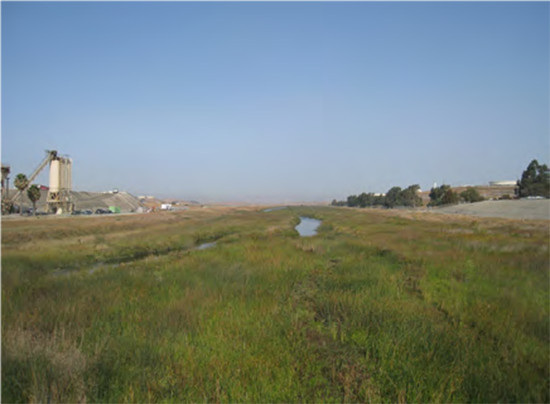
Lower Walnut Creek Channel[3] (Happy Valley Creek is a tributary)

Wildlife: Chinook Salmon, Coho Salmon, Steelhead Trout (from left to right, courtesy of NOAA Fisheries, http://www.nmfs.noaa.gov/)
Links to More Information
Environmental Protection Agency, Urban Runoff: Low Impact Development.
Contra Costa Resource Conservation District, Walnut Creek Watershed
Project Funding Partners
Funding for this project has been provided in full or in part through an agreement with the State Water Resources Control Board. The contents of this document do not necessarily reflect the views and policies of the State Water Resources Control Board, nor does mention of trade names or commercial products constitute endorsement for recommendation for use.
Funding has also been provided by Contra Costa Transportation Authority (CCTA) through the Contra Costa County Measure J transportation sales tax.
Questions
Please contact Aron Rice ([email protected]) with subject line “Lafayette Inquiries” for any questions or comments.
Language Assistance
If you need language assistance services, please call 510-464-6752.
若您需要语言帮助服务,请拨电: 510-464-6752。
Si usted necesita algún servicio de asistencia de lenguaje, por favor llame al 510-464-6752.
[1] United States Environmental Protection Agency, “Water: Polluted runoff – Erosion, Sediment and Runoff Control for Roads and Highways”, December 1995, http://water.epa.gov/polwaste/nps/road_runoff.cfm, accessed on January 23, 2014.
[2] Walnut Creek Watershed Council, Walnut Creek Watershed Inventory, prepared by Restoration Design Group. Feb 2013
[3] Walnut Creek Watershed Council, Walnut Creek Watershed Inventory, prepared by Restoration Design Group, Feb 2013.
